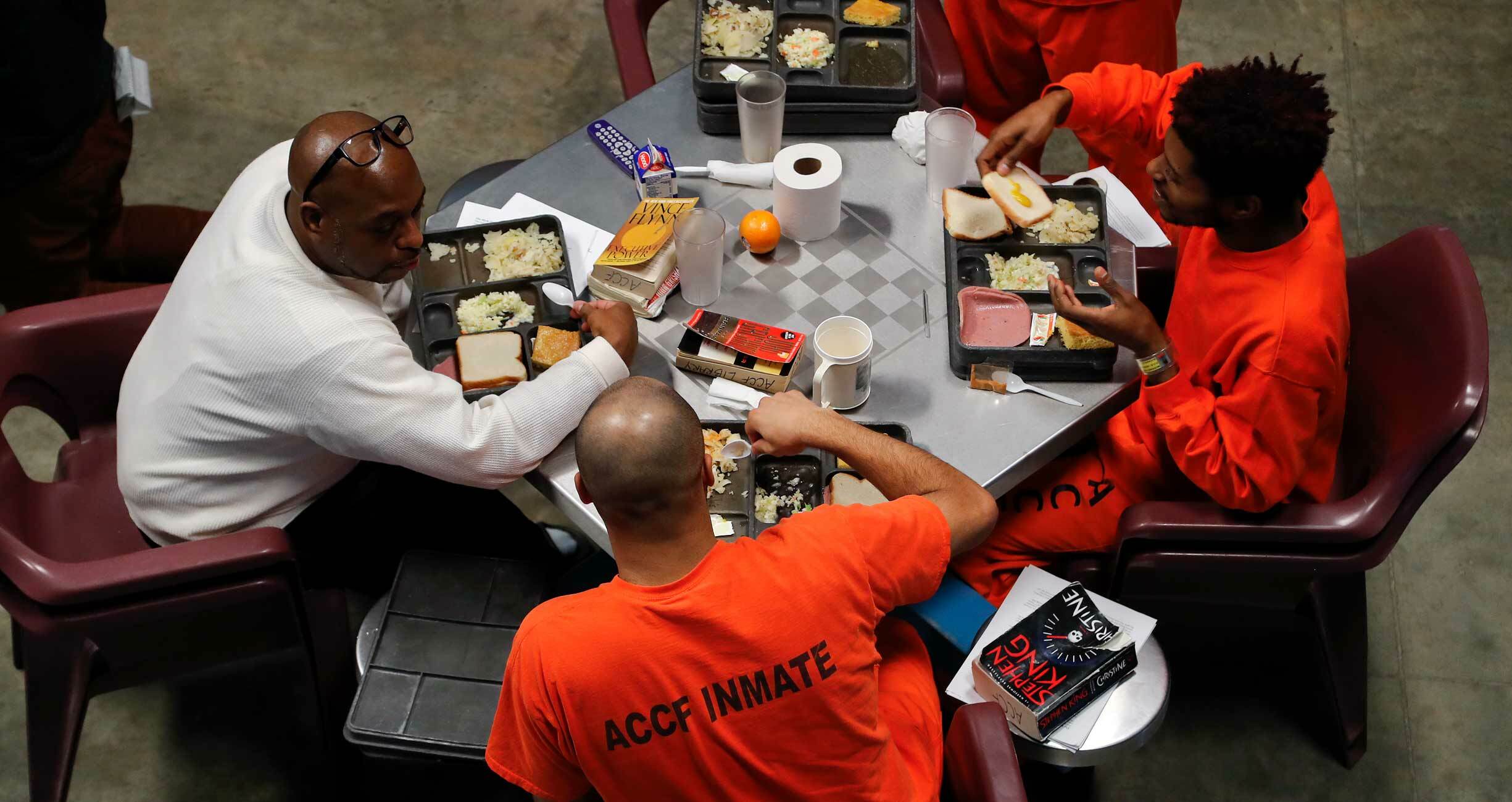

Penny-pinching on food services fleeces incarcerated people and their families and has adverse health impacts, all while lining the pockets of corporations. Better ways exist.
By Elizabeth Allen
“[It’s one of my] trademark meals to this day,” said Matthew of his unique spin on a Thanksgiving staple: pepperoni cornbread stuffing. It was the then-head cook’s answer to the lack of sausage available at his correctional facility in the Northeast. “I got everybody together, and I had everybody buy pepperoni off of commissary,” he recalled. With over one hundred packages contributed, Matthew’s crowdfunded concoction was a hit, and he made pepperoni stuffing for several years running afterward. And now, post-release, it features on his family’s own holiday table.
Maneuvering around constraints imposed by the ubiquitous Keefe Group—which supplies food and other services to correctional facilities nationwide—Matthew worked to make eating behind bars tolerable, even enjoyable. He resisted serving food he considered substandard and, whenever possible, heeded his peers’ requests and preferences. “[Food is] a sense of relief; when you can go to the kitchen and get a good meal [it’s uplifting],” he said. “I always tried to produce that for people.”
Still, despite Matthew’s ingenuity, his efforts were ultimately that of an individual person attempting to alleviate and make up for institutional failures to provide adequate, healthy food—a misconceived cost-saving measure that’s lucrative for  corporations.
corporations.
Most states spend less than three dollars per person per day on prison food services. Under Sheriff Joe Arpaio, the jail system in Maricopa County, Arizona, served meals only twice per day, which cost between 15 and 40 cents apiece. This focus on thrift means that the meals provide merely enough sustenance for survival—but prison food can endanger even that basic purpose.
In 2020, Impact Justice led a national investigation into prison food, finding that three out of four people surveyed were served spoiled food while incarcerated. This status quo is not just wrong, but unnecessary. Pioneering correctional institutions have devised systems that provide nutritious, satisfying food and save money.
“Prisons are food deserts”
In an essay for The Appeal, Michael Capers recalled the “contraband” that resulted in his first misbehavior report: “Vegetables from the mess hall that were about to be composted.” A vegetarian, Capers dubbed prisons—with their dearth of fresh food, not even available for purchase from the commissary—“food deserts.”
This lack of availability isn’t an isolated complaint. Impact Justice’s investigation found that 62 percent of respondents said they “rarely/never” had access to fresh vegetables, and nearly 55 percent said the same regarding fruit. And even when fresh food is provided, it’s typically low quality. As the spouse of a man incarcerated in Virginia quoted in the report noted, “Apples are often rotten, a fresh vegetable usually means a couple of carrot or celery sticks.” Matthew echoed this sentiment, saying that vendors often circumvent nutritional requirements with snack offerings: “[Fresh produce] wasn’t put into a meal.”
Commissaries supplement meals—for those who can afford it
Wielding his discretion as head cook, Matthew frequently utilized commissary products to ginger up vendor-provided meals. With his commitment to “accommodate every community,” he’d make Spanish rice for the Latino community if they bought olives. Jamaican peers would bring him curry powder for curry chicken. Other system-impacted people have even penned cookbooks, like Albert “Prodigy” Johnson’s Commissary Kitchen.
Yet the commissary is often out of reach—three out of five formerly incarcerated people reported having been unable to afford anything from it. At many facilities, necessities like soap aren’t provided and have to be purchased, making food a luxury item. Sampling three states, the Prison Policy Initiative found that incarcerated people spent an average of $947 at the commissary per year, significantly exceeding the typical prison job earnings for those states ($180 to $660 per year), indicating that many likely have outside financial help.
In some cases, the relationship between food service and commissaries is symbiotic. Many vendors, like the behemoth Aramark, the country’s largest food service provider, are contracted to run both meal services and the commissary. This can create a perverse incentive: the worse the meals, the greater the need to spend.
Even in facilities where separate companies manage food service and commissaries, that separation can be an illusion of corporate structuring, preserving this reciprocal dynamic.
One example is Ohio’s Cuyahoga County Jail, where Keefe recently became the commissary vendor. Keefe shares the same parent company as the jail’s preexisting food service provider, Trinity Services Group, Inc. (Trinity bills itself as “The Largest Contractor Dedicated to the Corrections Industry.”) Last June, Cleveland.com reported on the sharp decline of the jail’s already-poor food quality, concurrent with Keefe hiking prices at the commissary. Keefe raised the price of diced chicken breast by 136 percent from 2022; they increased the cost of a can of tuna, meanwhile, by $1.41. The Cuyahoga case is a plainly cynical example of corporations attempting to fleece people in prison. Trinity’s cheaply-produced dinner includes “mystery meat” and a “packet of lemon flavoring to pour in a cup of water,” steering repulsed and hungry residents toward Keefe’s extortionate commissary.
But many incarcerated people—without family support or an enterprising head cook like Matthew—have no choice but to subsist off the meager provided food. In 2020, when jails in Orange County, California, suspended hot meals as a pandemic safety measure, those without the means to buy extra provisions became ill. (The cold meals saved almost $1 million on food expenditures.) “It breaks your heart to see the elderly people and the people without funds on their books getting sicker,” said one person who endured the decline in conditions.
Poor food quality facilitates and exacerbates illness, adverse health outcomes
A study found that each year spent in prison “translated to a 2-year decline in life expectancy.” It’s easy to see how.
Foodborne illnesses are, perhaps, among the most immediate and universal risks for incarcerated people—research findings indicated they were six times more likely to contract them.
Prison diets could also have a cumulative impact, worsening issues for people with existing chronic diseases and, for others, helping lead to their development. According to the United States Department of Justice (DOJ), 44 percent of people incarcerated in state or federal prisons reported ever having a chronic illness, compared to 31 percent of the general population. People released from state prison in 2018 had served an average of 2.7 years, the DOJ found—and it only takes four weeks of eating a poor diet to cause lasting impact.
Prodigy’s initial interest in cooking came from his desperation to stay healthy because he has sickle cell anemia. “[It is] no joke, so I couldn’t eat poorly or not exercise,” he told NPR. “And everything in jail is designed to do the exact opposite.” Like many chronic diseases, managing sickle cell is difficult, and doubly so from behind bars. Prodigy’s mess hall served green vegetables only once weekly.
To artificially meet health requirements, especially calorie minimums, meals are packed with refined carbohydrates. For key nutrients, powdered drinks stand in for whole foods. A study conducted in a rural Southwest jail found that daily meals had 156 percent more sodium than is recommended. Even seemingly healthy options, like oatmeal, are over-sweetened and low in fiber.
People in prison were 150 percent more likely than the general population to report histories of diabetes, asthma, or high blood pressure, according to the DOJ. Nearly one in four incarcerated people have hypertension. They, too, have higher rates of hearing, vision, cognitive, and ambulatory disabilities than the general public, which the abysmal nutrition in prisons and jails surely doesn’t help.
Visionary correctional facilities and new policies show what’s possible
Matthew says his ability to positively influence the experiences of others was what “helped [him] make it through.” But it shouldn’t be up to one person to guard against serving expired food or to ensure that it’s edible. There are jails and prisons with systems worth emulating, however.
Mountain View Correctional Facility in Maine operates a garden and bakery staffed by the people incarcerated there. The fresh produce, as well as homemade bread and more, are prepared by the kitchen for residents to enjoy. The program saves the prison nearly $100,000 yearly, reducing reliance on vendors and, for residents, the commissary.
The Sustainability in Prisons Project is another visionary example. The Washington Department of Corrections and Evergreen State College run beekeeping and composting programs onsite and coordinate with local partners to harvest fresh produce, which is shared among all 11 state prisons as well as with nearby food pantries. (In 2018, there were 246,700 pounds’ worth.)
In October 2023, California Governor Gavin Newsom signed into law the Basic Affordable Supplies for Incarcerated Californians Act, aiming to curtail commissary price gouging. (Products are marked up as much as 200 percent in the state.) And in December, New York State senators introduced the Rights Behind Bars bill, which, crucially, would mandate regular access to “wholesome and nutritious food,” including fresh fruits and vegetables.
These are encouraging developments and, in tandem with models like those in Maine and Washington, demonstrate how stakeholders can and should ensure people in prison are treated with dignity—not sickened and swindled.
Originally published by Vera Institute of Justice.





